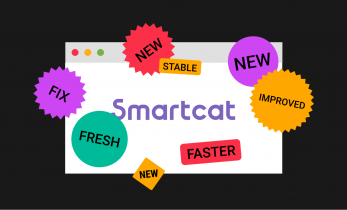Greater than 6 minutes, my friend!
Translating 1,000 words per hour: is it possible? Some thoughts on the future of productivity
A couple of weeks ago, Lilt, a new online CAT tool developed by scientists and trying to shake up the world of translations, published the results of its own research about the productivity improvements the platform wants to bring to translators. According to the platform developers, Lilt outperformed Trados with an average productivity increase of 21.9% among human translators. However, the fact that the fastest translator achieved an output of 1,367 words per hour gained much less attention. Will Lilt set the new standard?
About Lilt
Lilt is a brand new translation platform that was introduced only a few months ago. The platform is entirely cloud-based and combines human translations with machine translations. It has interesting features like auto-suggest based on previously translated segments and an intelligent pre-translation feature with smart tag placement that does not require editing segments anymore.
Lilt explicitly tries to shake up the translation industry. On the company info page it states: ‘Human translators can guarantee quality, but are comparatively slow and expensive. Machine translation is fast and cheap, but quality ranges from surprisingly good to comically bad. Somewhere between these two extremes is a human+machine partnership that can produce good translation quickly’. In other words, Lilt wants to provide faster and cheaper human translations by combining human and machine translations in one screen while adding technology to produce better results.
Currently, the platform does not support many languages, but it is progressively rolling them out.
@Lilt at @tenvcongres: UI based on eye tracking information. Disruptive in its own! pic.twitter.com/FWKPXNqGWq
— Pieter Beens (@vertaaltnu) March 11, 2016
Lilt vs Trados
To show the implications of this goal in real life Lilt set up a productivity contest against Trados. Five in-house English–French translators from e2f, a French translation agency that I know from experience has high quality standards, worked one hour with Trados and one hour in Lilt, after which the results were analyzed. The translations were coming from two different genres: UI strings from a software product and a hotel chain loyalty brochure.
In the case study (PDF) that was published on their website Lilt explains the study method in detail. As far as I can judge, it was a sound methodological approach, designed to prevent giving an unfair advantage to either tool while stimulating translators to translate unknown content as quickly and accurately as they could.
For the UI data, translators translated 21.9% more source text on average with Lilt while for the hotel data an increase of 13.6% was found. The maximum throughput was 33.2% vs 14.6% respectively. The table below, taken from the case study, shows the study results for the two genres after correction.
According to Lilt the maximum productivity was 1,367 raw words (before correction) per hour – a staggering amount. As the table above shows, an output of 762.6 to 991.3 words per hour was still measured after correction.
Translation productivity per hour
With about seven years in the industry I am quite a newbie. However, that experience, combined with my keen interest in translation technology, has enabled me over the years to explore new depths and to start working without any limitations. I soon learned from companies that a translator should translate about 2,000 words per day or 250 words an hour. I am not sure where this amount stems from but I think it is based on a standard from a couple of decades ago – before CAT tools made their way into our industry. Seven years ago 2,000 words per day was a maximum standard and translating more words was not only unthinkable but even undesirable.
Much has changed. Many companies I work for respect translators who are able to translate 3,000 words per day. The companies that try to win new clients by promising a turn-around time that had never been thought possible in the industry (or that is simply unreasonable), or who cut rates so far that they increase the throughput exponentially in order to earn a living, wish for or even demand a higher volume per day.
Among translators, standards have shifted as well. Where those who produced larger volumes a couple of years ago were regarded as ‘cheaters’ or unprofessional translators with low quality standards, well-known and high quality translators are now translating 4,000 words a day. The translation industry has broken adrift – even while groundbreaking technologies like machine translation are not yet fully employed and sometimes even rejected.
Put simply, business factors like lower rates and faster developments together with technological factors, like smarter CAT tools and new technologies, are requiring and/or enabling translators to work faster. According to a Proz.com poll held in 2005, 28.6% of the respondents translated at the ‘old’ standard of 200–300 words per hour. In 2013, a poll conducted on the same site showed that a majority of the translators (37.2%) still translated the equivalent of 2000–3000 words a day, while 29.5% translated 1000–2000 words a day. A poll in October 2015 showed that 31.8% of the respondents translate up to 2000 words a day, while 53.5% of the respondents translate 2000–4000 words a day. Several factors make it impossible to conclude that productivity increases, but the discussions for each poll make clear that 2,000 words a day is still a highly regarded standard. Some translators are able to translate many more words on a day, but in the 2015 poll only 2.3% of the respondents agreed to translate more then 6,000 words per day. Some translators admit publicly that they can translate more than 8000 words a day, but they are only a minority.
Analyzing the results from the Lilt study shows that the translators from e2f are used to translating more words per hour than the standard 250–300 as well: they are used to translating at least 723 words at their ‘normal’ pace. That’s quite productive for a translation agency that originally set the output for their translators at a max. of 3,000 words per hour…
1,000 words per hour: is it possible?
In the Lilt study one of the translators was able to translate 1,367 words in one hour – about 114 key strokes per minute. Because the study only took two hours it is difficult to make conclusions about daily output. Thirteen hundred sixty-seven words is nevertheless a huge amount, more than five times the old average of 250 words per hour. The amount of words is further confirmed by the results of the polls cited above, which were conducted before Lilt was even introduced. So yes, translating 1,000 words an hour is possible. Furthermore, I know two translators who are able to translate 1,000 words per hour – a confirmation from my own practice. I have been able to translate 1,000 new words (and even more in a few cases) per hour as well but that is only possible in certain circumstances: you need to have the right resources, a fast PC and translation memory, segments of the right length (segments with only two words seem to consume more time for updating the TM than segments with more words) and a good dose of coffee. But afterwards checking and editing will reduce the average amount so that a raw 1,000 words is different from a net 1,000 words per hour. And translating 1,000 words per hour does not necessarily mean that you will translate 8,000 words in an eight-hour working day.
I think that most translators are unable to produce 1,000 words per hour, but those who do, do not speak about it that loudly. I understand. Admitting that you are able to work as a robot almost automatically leads to questions about quality – even when you have always delivered the best possible translations (while translators with lower daily volumes can evidence the contrary in some cases). For me it won’t come as a surprise if more translators confess that they can handle 1,000 words per hour.
Is a higher volume the future?
To be sure, when I read the results of the Lilt study I became afraid. Publicly admitting that translators can produce more than 1,000 words per hour can quickly result in greater demands from the translation industry and a much higher burden. It also can reduce the quality of newly generated translations, which can influence society as a whole. If we sometimes are driven crazy with lower workloads, would we go mad from translating 1,000 words per hour? And if we’re already translating 1,000 words per hour, should we produce even more words to outperform our colleagues or to remain the preferred translator for our quick deliveries? These are questions that are still unanswered.
However, the future seems dark in some respects. The Lilt study speaks about translation productivity in terms of ‘throughput’ (a term used more by translators who are able to ‘produce’ 1,000 words per hour): it calls for associations of human robots, people that work like crazy to deal with an ever increasing workload.
On the other hand, it can also be said that there is not much to fear. In the past years technological developments have enabled us to increase our productivity from 2,000 to 4,000 words per day – an increase of 100%. A new increase with the same amount is far more difficult to reach, but perhaps the industry will enable us to do it without going insane. At the same time not every field will lend itself to similar work rates: some specializations will always be behind because of quality constraints. And finally, translators decide the productivity of the industry as a whole. Those who want to translate 2,000 words can still do that and be regarded for their quality, while those who translate the same amount in two hours can be regarded for their quality and fast delivery. They can even serve the same clients and work together, ensuring that every need is met.
Let translators do what they can (and want to) and let quality, rates and delivery be the imperatives for the whole industry.






It is possible. I just did it. Well, 800 words. In roughly 50 minutes. But: I have a well-maintained TM for that client and it was a quiz for a landing page. Hence, half of it was short questions (tourism: What’s your favorite cocktail? What’s your favorite animal? and the like) with answers from one to three words. And the other half was the results of the quiz plus a bunch of terms common in most any modern UX. It really depends on what kind of text and the quality of the TM.
Aside from that, I am sure that there will be loads and masses of (web) content in the future with a super short shelf life that simply do not require quality of the highest kind. For those, MT will be great.
But back to output. Since I covered my average must-have turnover for the day in these 50 minutes, I will go and kick back now and come back to my translation later to revise. 🙂 Because one thing is for sure: I could not go at this rate 8 hours straight a day. Guess that’s the difference between humans and robots.
Great article, Pieter! I’m fascinated by translation technology and just like any other professional I’m always looking for a way to improve my productivity. However in my field (video game localization) it’s not always possible. Sure, there are strings where both translation memory and machine translation can be of great help, for example, when translating UI elements or menu items. But the majority of texts I work with are non repetitive and require a decent amount of creativity and frequent use of transcreation. This is something that translation technology can’t really handle at the moment. Same thing happens with marketing, advertising, literature and many other fields, where approach is more about “creativity” rather than “volume”.
I believe that machine translation can improve productivity, but technology companies should also emphasize that it only works in certain domains and cannot really improve the productivity of each and every translator out there. Otherwise it creates a bit of a confusion among the recipients of such translations (end clients).
Also, for Proz poll results to provide some decent data we really need to conduct those polls within a specific group of professionals who work in the same field. That way the productivity data will be way more accurate and reliable, imho 😉
P.S.: I’m still reading their study, but it seems like 1 hour is not enough to jump to conclusions about productivity increase. I’d love to see a study where subjects had worked at least 1 month in each tool. I feel like it would be more accurate. 🙂
A very interesting article, Pieter. Thanks for sharing it. I mentioned machine translation in my talk about change management at the bp16 conference in Prague and said that it could be put at the service of translators. Some people felt inspired, others hated the idea. Many translators associate MT with poor quality and are reluctant to see how humans and machines can work together. Do you think this will change?
Good question, Christelle! I wonder why did people hate the idea? Did they explain their point of view? In my humble opinion, we need to pay more attention to the technology instead of hating it. Otherwise it will be much easier for technology companies to abuse us and ignore our opinion (haters gonna hate, that kind of thing). I think, we need to focus on collaboration and figuring ways how to make technology work for us and not against us.
Thanks for your comments Christelle!I experience the same feelings from colleagues. I believe MT will grow further in the future while the quality is improved. It can be of great help for us, but we should stress the importance of linguistic quality – often a concern. I think people are mainly afraid for losing their job, but personally I feel we should jump on the wagon now to enjoy the fruits in the future.
Verzonden vanaf mijn Samsung-apparaat
This was the topic of my talk in Prague, and as you can see from another Open Mic post, some people have a different opinion and didn’t agree with what I said: link to theopenmic.co
Thank you Pieter, you gave us a lot to think about. The Lilt study is interesting and your article made me think about how I consider myself and my work in terms of productivity. Am I a valuable pro (if ever) because I can produce a lot of words, because I deliver high quality words, or a lot of high quality words? It made me think where I want to stay. One thing is clear to me. Technology isn’t an enemy, just a tool. We can take advantage of it as much as companies do. Agencies and end clients can’t do much with tons of technology if they can’t rely on good language experts. There’s still room for human skill and talent…
Very interesting and thought-provoking article Pieter, thanks for sharing.
In the past I have been able to translate up to 3,500, maybe even 4,000 words per day, which I consider to be my ‘record’.
However, as Tanya and Dmitry point out, this largely depends on the translation’s subject as well as the type of TM you use.
Also, in my experience, whereas it is occasionally possible to translate a record amount of words in a day, this is not sustainable for more than a few days, unless you want to risk having a nervous breakdown….
Informative and well articulated post indeed. Ripples of thanks Pieter.
As you know, translators’ output (productivity) depends mainly on the text-type of the source text and the translation directionality (whether you translate from or into your native language), in addition to many factors like whether you take the word count of the source or the target text.
For some text types (for example legal ones like in a memorandum of association), 1000 words per hour can be easily achieved without translation machine.
Great read Pieter. I’m a huge fan of LILT as well. I like innovation. I don’t know if I’m more productive with LILT, but somehow this new tool is addictive. It kind of shows the magic of pre-processing in real-time — other tools are not showing this. And the fact it is interacting with my brain, is probably what makes it so addictive.
Still I keep on using my regular CAT as well. Sometimes it is just easier to work on static pre-translated sentences. It is also easier to make a quote based on a static analysis.
A last thing I want to share about LILT: working on a dynamic pre-translation feels more like real translation work again. I feel less of a editor, while in fact, I still am editing. The feeling is different. That kind of work satisfaction is important as well.
Ok, now when you’ve described it like that I want to try it too, haha! 🙂
… and I even don’t have shares in the company, Dmitry 😉